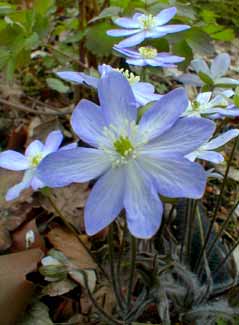
Powder Blue American Roundlobe
Woodland Hepatica; aka,
Liverleaf, Mouse Ears,
or Squirrel Cup
"The winter snow
Will suit it better than those lips of thine
Whose fires would but scorch it, rather go
And pluck that amorous flower which blooms alone."
-Oscar Wilde
(1854-1900)
(1854-1900)
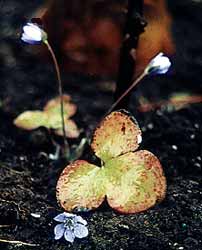 Hepatica nobilis was formerly divided into numerous species, but today several that were formerly recognized as distinct are regarded as subspecies, variants, & cultivated forms of H. nobilis.
Hepatica nobilis was formerly divided into numerous species, but today several that were formerly recognized as distinct are regarded as subspecies, variants, & cultivated forms of H. nobilis.These differing forms are found throughout much of the Northern hemisphere. Arguments remain as to which Asian & European variants of H. nobilis should or shouldn't remain categorized in separate species. The variety of this "one" species has been further extended by nursery hybridization, producing new colors & intermediate variants.
We started with only two Hepaticas, but they were so pleasing we added others, & continue to do so, especially whenever we happen upon unusual but at least halfway affordable ones.
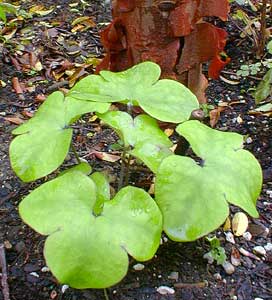 We're not apt ever to have the enormously rare hybrids, which can cost hundreds of dollars each, but even "regular" hepaticas have considerable variety, & are only a little more expensive than ordinary perennials.
We're not apt ever to have the enormously rare hybrids, which can cost hundreds of dollars each, but even "regular" hepaticas have considerable variety, & are only a little more expensive than ordinary perennials.The varied color forms are usually just sold as "Mix" & only occasionally treated as named cultivars, & must be selected in late-winter flower to be assured of different colors.
I named this deep sky-blue specimen "Powder Blue," as it is a daisy-like bloom reminiscent of Blue Marguerite Daisy. This is the American variant "obtusa," or Roundlobe Hepatica, in contrast to "acuta" or Sharplobe Hepatica of Asia.
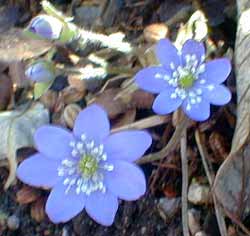 Formerly the Sharplobe was afforded its own species H. acutiloba, while Roundlobe was H. americana. Because they hybridize freely when grown in proximity, many intermediate leaf-shapes cannot be assigned to one or the other variant.
Formerly the Sharplobe was afforded its own species H. acutiloba, while Roundlobe was H. americana. Because they hybridize freely when grown in proximity, many intermediate leaf-shapes cannot be assigned to one or the other variant.Roundlobe or American Hepatica is native to the eastern half of North America, where it lives in the shade of deciduous woodlands getting sunlight only in winter. That's why its leaves are evergreen through winter, the season during which it undertakes the majority of its photosynthesis to extend its rhizomatous roots.
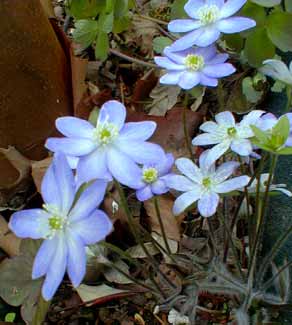 Hepaticas often rebloom after their first late winter or early spring flush of blossom, & sometimes will have a random bloom as late as June. But this particular clump stops blooming in early April. The third photo, taken late April, shows only the fully renewed, gorgeous, persisting leaves, with flowers no longer in evidence. The floweriest photos were taken February & March.
Hepaticas often rebloom after their first late winter or early spring flush of blossom, & sometimes will have a random bloom as late as June. But this particular clump stops blooming in early April. The third photo, taken late April, shows only the fully renewed, gorgeous, persisting leaves, with flowers no longer in evidence. The floweriest photos were taken February & March.When the flowers first appear, the previous year's leaves can seem to be quite worn-out. The "grubby" photo above shows it in February (2003) with new blooms just starting, but old leaves that made it through winter, showing the liver-coloration of the worn out leaves.
Spring's bright green leaves become nicely colored as autumn progresses, until eventually they have taken the "liver" coloration which inspired the name Hepatica, alluding to the hepatic system, or liver. When new leaves are beginning to appear, that's the time to remove the old ones, though nothing bad happens if you fail to do so.
These humble yet winning flowers with white stamens against purest blue adds up to a striking appearance. Most of the other clumps which are planted around this one are the acuta or sharplobes, some of which start flowering one to three weeks later, each clump behaving slightly differently. Some will already have tiny immature leaves, as whether the flowers start first, second, or simultaneously is an individualistic quirk from one clump to the next. Even if the leaves do emerge ahead of the flowers, they'll still be extremely tiny when the flowers are up.